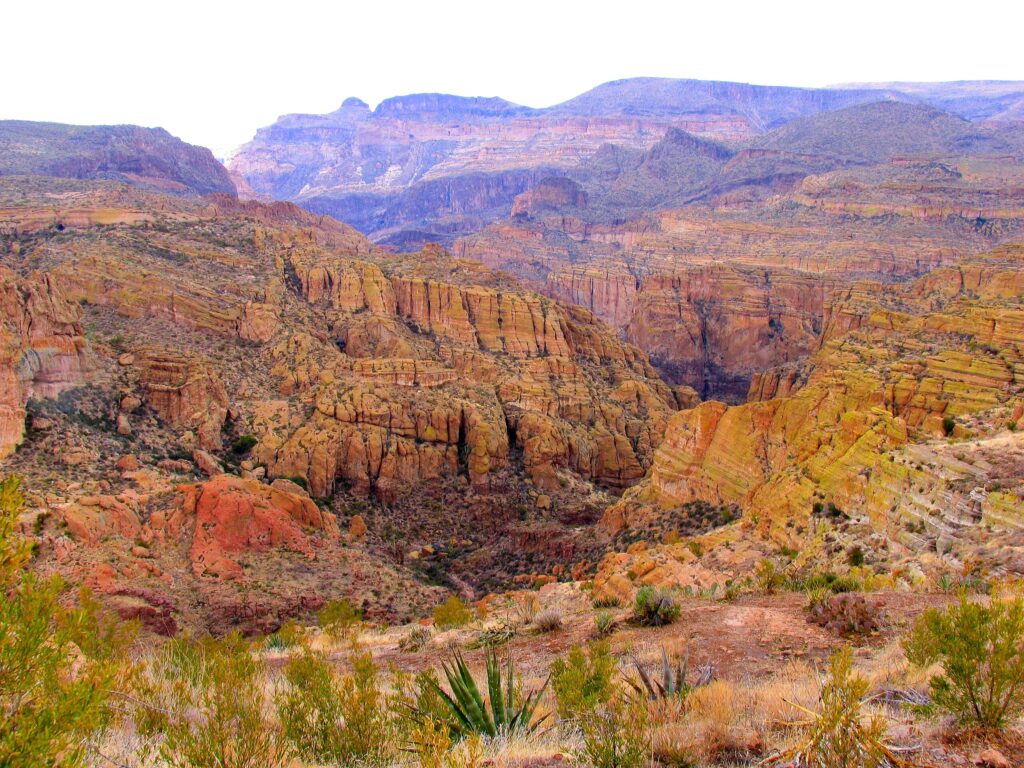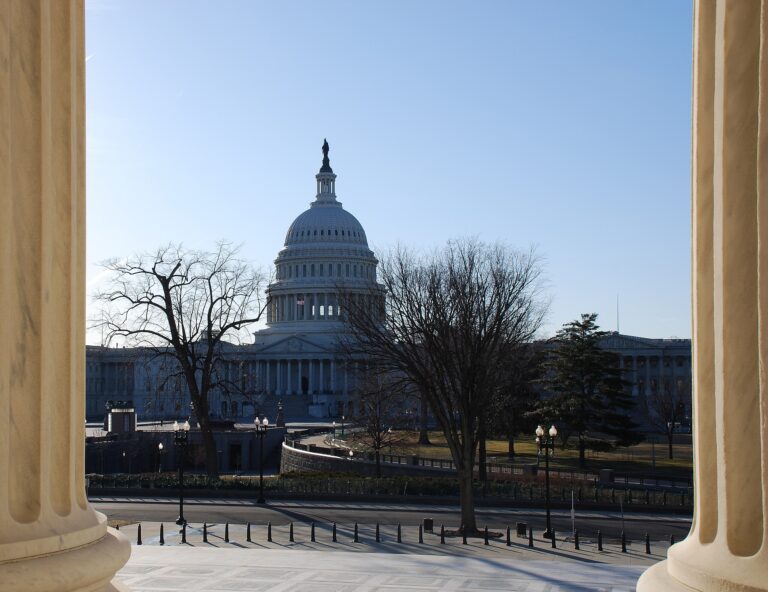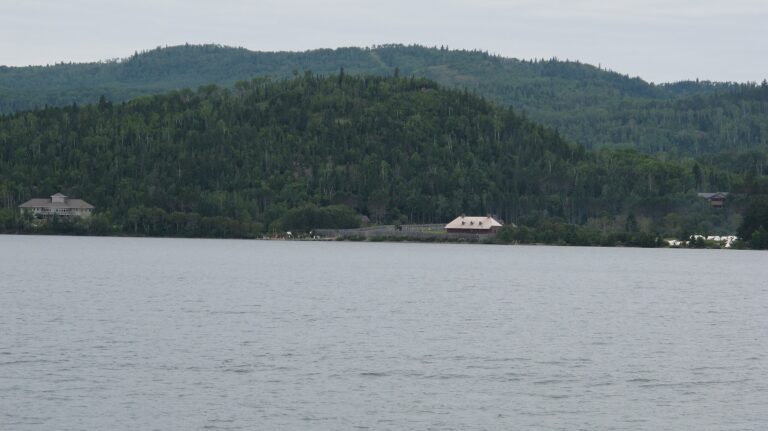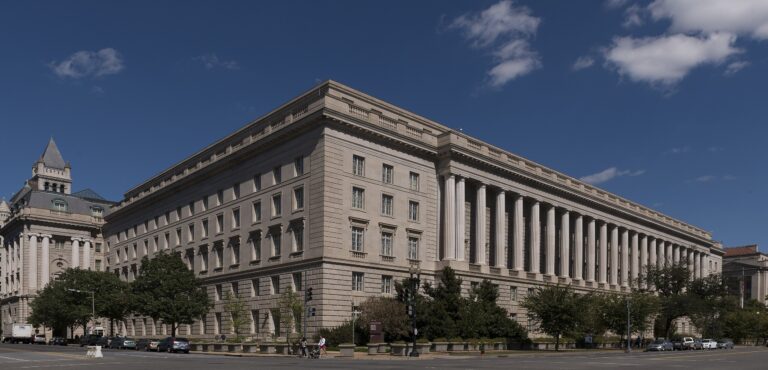
Traditional Ecological Knowledge (TEK) and Indigenous Religious Freedom: The Case of Chí’chil Biłdagoteel
Brady Earley
Tonto National Forest by Janet Ward (CC BY 2.0).
Among the Supreme Court’s most significant decisions on religious exercise this term was the decision not to act. The case—Apache Stronghold v. United States—was relisted 17 times before the Court issued a denial of certiorari indicating they would not hear the case. The conflict involved a multi-year battle over Chí’chil Biłdagoteel, also known as Oak Flat. This Apache sacred site in Arizona was transferred from the federal government to a copper mining company who plan to blast Oak Flat to construct a copper mine.
The Supreme Court’s refusal to hear the case strikes a heavy blow to the San Carlos Apache in their efforts to halt construction of the mine. In a dissenting opinion to the denial of cert, Justice Neil Gorsuch called the decision a “grave mistake.” While the Apache are currently exhausting all remaining options to preserve their sacred land, some—including President Donald Trump— have criticized these efforts as “dubious” and “anti-American”, citing the intense need for copper in the country. But religious freedom advocates argue that transferring Oak Flat will threaten religious freedom for all Americans.
In these heated debates, something that has escaped attention is the environmental dimension to the Oak Flat dispute. A growing body of empirical evidence supports efforts to involve tribal communities in natural resource management and conservation across the United States. Studies increasingly emphasize the environmental benefits arising from Indigenous traditional ecological knowledge (TEK). TEK has been defined as “a body of observations, oral and written knowledge, innovations, practices, and beliefs developed by Tribes and Indigenous Peoples through interaction and experience with the environment”
Perhaps surprisingly, both the Trump and Biden administrations have historically supported the use of TEK. Yet, they have failed to acknowledge the essential connection between spiritual beliefs and TEK as shown in the dispute over Oak Flat. This essay discusses the evidence of this connection and suggests why overlooking it is problematic for law, religion, and environment.
TEK in Environmental Conservation
A key piece of Indigenous approaches to environmental stewardship is the relationship between Indigenous spirituality and attitudes toward the environment. In many tribes, TEK represents an intergenerational accumulation and transmission of knowledge that is passed on through religious rituals on Indigenous sacred sites. Because of this, TEK is more than just careful observation of the natural world or local knowledge from dedicated conservationists. Rather, TEK is a religious responsibility for many tribes; it is vital to the spiritual survival of Native traditions and the custodians who bear them as much as the physical survival of the environment.
As the value of Indigenous TEK to environmental protection has slowly grown to its current level of empirical verification, national governments are also beginning to rely on these practices while the environmental crisis becomes more precarious. The United States, for example, has recently demonstrated growing support for policies on Indigenous land management and the integration of TEK. In 2018, research supported by the U.S, Department of Agriculture’s (USDA) Forest Service in Acadia National Park highlighted the benefits of the Wabanaki Tribes’ TEK on cultivating sustainable harvests of sweetgrass. At Mount Rainier National Park, the effects of Nisqually TEK on beargrass, pipsissewa, western red cedar, and Alaskan yellow cedar bark harvesting were recently studied. The results demonstrated that TEK generally poses less risk to plant mortality compared to commercial harvesting practices while still maintaining the same levels of harvest production.
An example from the Sierra Nevada range demonstrates how growing scientific support for Indigenous TEK is now influencing policymakers to adjust their approach to environmental protection. The North Fork Mono Tribe inhabits lands near Sierra National Forest including many meadows undergoing recent restoration treatment. Ron Goode, a North Fork Mono tribal leader, expressed concern that restoration treatments would adversely affect native wildflowers that are critical to sustaining the insect population through winter months. Consequently, Goode “called for leaving some of the remaining bull thistle plants as a food source; meanwhile a local forest service specialist expressed a desire to remove all of them because they are an invasive, non-native species.” Over time, research began to show that “leaving residual non-native floral resources can be important to sustain native butterflies until the floral community recovers,” thereby substantiating Goode’s reliance on Indigenous TEK. A 2020 article from the Forest Service highlighted its fruitful partnership with Goode and the North Fork Mono Tribe, utilizing the Tribe’s TEK to restore meadows and oak trees.
Primed with the benefits of Indigenous TEK on environmental protection, efforts to include Indigenous peoples in environmental management have become a priority in American domestic policy. The National Park Service has compiled nearly 50 studies of the environmental benefits of TEK and highlighted dozens of applications across the United States. Yet, for TEK to produce these desired benefits, its spiritual roots must also be understood.
TEK and Indigenous Spirituality
While the insights from Indigenous TEK vary from tribe to tribe in the US, one largely common feature is their grounding in Native American traditions and beliefs. Although “religion” may fail to capture the holistic, fluid, and heterogeneous nature of Indigenous spirituality, it can proxy for the sacred relationship between Native American tribes and their native lands. Given that many Native Americans believe “living in a harmonious and sustainable relationship with the land is a sacred responsibility,” Indigenous Tribes often emphasize how “neglect of this responsibility will bring dire results and retribution from the Earth.” Across different tribes, Native Americans hold beliefs that reflect this fundamental responsibility into all dimensions of living, encompassing what many Indigenous peoples refer to as their “lifeway.”
Religious elements within many Native American lifeways are fundamentally tied to land. Whereas Western institutions, including religion, are often defined temporally, the Native American experience is usually spatially oriented. Traditional tribal lands provide exclusive sacred spaces where ceremonies are conducted, rituals performed, and traditional knowledge passed down to future generations. For example, the Pueblo peoples in Jemez, New Mexico (also called Hemish) believe “knowledge of ritual and the spiritual world represents the source of power that can influence nature’s forces.” Their primary sacred shrine, Wåavēmå Mountain, sits within Valles Caldera National Preserve and provides a focal point around which both spiritual and environmental knowledge can be shared within the tribal community.
Respecting the sacredness of Wåavēmå Mountain, the Hemish carefully guard the traditional knowledge shared in their religious ceremonies including their TEK. For the Hemish and many Native American tribes, “the spiritual and natural worlds are not separate.” Environmental practices such as subsistence farming, traditional plant gathering, and hunting constitute “both the spiritual and physical means to continue [Hemish] heritage.” In the words of Pah-Tow-Wei Paul Tosa, traditional leader and former governor of the Pueblo of Jemez:
On the one hand, celebrations, stories, songs, dances, and spiritual practices are performed for successful subsistence farming, hunting, and traditional plant collecting; on the other, we need what we bring home from gathering, hunting, and our fields to perform our traditional practices. These practices teach skills that determine the future success of younger tribal members as providers and productive members of the village and ensure the perpetuation of the culture for generations to come.
The traditional knowledge present in those sacred ceremonies is only passed on to fellow tribal members at certain times and places, thereby ensuring traditional knowledge does not leave its sacred spaces without appropriate consent and permission. If TEK is shared outside the Hemish community, it is done “through respectfully listening to the voice of the Hemish people.” As a result, Pah-Tow-Wei Paul Tosa emphasizes that “Indigenous peoples need to be recognized as indispensable caretakers of traditional lands” in order for their traditional knowledge to be available to future generations.
Like the Hemish, many tribes in the Great Lakes region also understand TEK as bound up within their spiritual traditions and rituals. The Little River Band, Menominee, White Earth Ojibwe, Rainy River Nation, and other tribes have “designed public ceremonies . . . to commemorate the ways sturgeon plays a key role in highly interdependent, local ecosystems.” These ceremonies serve an important pedagogical function of passing knowledge to the rising generation where each ceremony possesses spiritual significance because of the “moral relationships, especially accountability, that are tied to the pursuit of scientific knowledge.” As a result, sacred sites where this knowledge is bestowed to future custodians are “endowed with sacred responsibilities.” In doing so, these sacred sites can connect the rising generation to “past and future generations and the continued flourishing of their peoples.”
Another example of the tie between sacred lands and knowledge is found in the Karuk tribe. The Karuk tribal territory in Northern California contains several sacred sites subject to U.S. Forest Service (USFS) oversight. In 2017, a USFS incident management team determined that a Karuk sacred setting required fire suppression due to overgrowth of several species invading the site. Unfortunately, without available firefighter crews, the USFS team instead bulldozed the site, damaging physical artifacts and erasing the cultural landscape of the Karuk. The result is what Dr. Frank Lake calls a “third order effect” of the fire. Whereas the first order effect of the fire changes the landscape directly and the second order effect would be to regenerate new species, the third order fire effects impact “socio-cultural responses to environmental conditions.” In this case, the third order fire effect inhibited the Karuk’s “future ability to learn from ancestors and the land.” Because their sacred site wasirreversibly altered, the Karuk permanently lost a vital source of TEK embedded in that landscape.
Conversely, when Karuk sacred lifeways are respected, their TEK has been a boon to habitats and ecosystems. Similar to the USFS, the Karuk have advocated traditional burning practices in certain areas “to restore hardwood groves, prairies, meadows, and open forests.” However, according to their belief system, burns should not take place between April and mid-June in part due to the risks they believe would come to plants and animals. This Karuk practice was substantiated by a study on fisher pups that likewise cautioned against “prescribed fires during several weeks in the spring, due to the potential for carbon monoxide to accumulate in den trees.”
Beyond sustaining Indigenous TEK, the Karuk example illustrates how spiritual practices can effectively address environmental challenges. As many environmental activists have noted, climate change requires proactive responses; otherwise, the time when people feel compelled to react will likely come too late. Similarly, as calls are made for increasingly drastic measures to respond to urgent environmental threats, institutions and individuals may lack the will and resources needed to combat the crisis. Localized Indigenous knowledge is well-positioned in these situations to swiftly implement their time-tested practices in aid of the environment like the Karuk. More fundamentally, spiritual beliefs and practices are a sustainable force for taking needed action. This is particularly helpful in extending the impact of short-term scientific funding incentives through the deep spiritual connection Indigenous people maintain with their lands.
TEK and Religious Freedom
The ultimate resolution of the Oak Flat controversy carries fundamental consequences for TEK. The land exchange relied, in part, on the government’s interest in environmental conservation. It is therefore puzzling why the government is justified in the desecration of Oak Flat and the associated loss of TEK which are core to such preservation. For example, the land exchange aims to benefit riparian conservation efforts in the lower San Pedro River which will be managed by the Department of Interior. Yet, White Mountain Apache TEK has a demonstrated record of restoring riparian and wetland ecosystems in the same region. Critically, those involved in the restoration pointed to the presence of TEK as one of the reasons for their success beyond previous conservation efforts. By damaging sacred sites on Oak Flat, the ceremonial passing of TEK will be disrupted and likely threaten the sustainability of riparian ecosystems under the White Mountain Apache’s care. But if comparable efforts are underway to preserve riparian ecosystems in the region, government must justify its decision to favor these methods over TEK. Indeed, under cases like Tandon v. Newsom and Kennedy v. Bremerton School District, the Supreme Court requires heightened scrutiny when government “treat[s] any comparable secular activity more favorably than religious exercise.”
The land exchange’s acknowledgement of harm to Emory oak grove is another example of favoring comparable secular conduct over religious that injures the government interest in the environmental conservation. The Oak Flat Draft Environmental Impact Statement (DEIS) acknowledges the irreversible damage to the Emory oak grove and TEK that will occur after the mining project is approved. What is not explained is how the Forest Service has worked closely with the Apache to try and restore Emory Oak through TEK due to its ecological importance in Arizonan forests. Since 2018, ongoing restoration of the Emory Oak groves has been a collaborative project between the Forest Service and the San Carlos Apache. The project was initiated by the San Carlos Apache when Tribal elders began to note the declining acorn populations in the vicinity of the oak grove from the Emory Oak Grove. In addition to assisting the Forest Service in preserving the Emory oak groves, this project also addresses food security concerns in the San Carlos Apache tribe. The collaboration between the San Carlos Apache and the Forest Service—which relied upon TEK—has been held up as a model of local cooperation and management of important environmental resources.
Despite this and other examples where the San Carlos Apache TEK has advantaged U.S. Forest Service environmental conservation efforts, the government chooses to disregard these benefits. In doing so, it lacks a response for why its environmental and conservational interests are not undermined from the land exchange. Losing TEK appears to be a clear consequence of mining in Oak Flat and thus lead to environmental loss. But the land exchange is clear that environmental conservation is a priority and condition of the exchange. Given this puzzle, the natural course to take is to request an explanation from the government.
Turning to greater scrutiny of government justification should not be viewed as a loss to the Forest Service or USDA. Without more careful study of the ways that the land exchange could affect the Apache’s TEK and the role it plays in preserving the surrounding environment, the government could be stepping into a very counterproductive agreement. The legal doctrine of strict scrutiny encourages the government to show with evidence that the proposed land exchange will in fact accomplish what they are hoping it will.
Conclusion
As the foregoing analysis has emphasized, Native American sacred sites and spiritual traditions are the lifeblood of many environmental benefits realized through TEK. Because Indigenous TEK is inextricably tied to spiritual beliefs and traditions nurtured on Native lands, corresponding protections for Indigenous sacred sites are necessary to the existence of TEK. Although government policy often seeks to enjoy the benefits of TEK, it has thus far neglected to care for the sacred spaces where TEK is preserved. Reversing course would benefit the environment but more importantly restore Native American sovereignty over their religious exercise. ♦

Brady Earley is a JD/PhD student in political science at the University of Chicago. His research uses empirical methods to study constitutional law, including law and religion.
Recommended Citation
Earley, Brady. “Traditional Ecological Knowledge (TEK) and Indigenous Religious Freedom: The Case of Chí’chil Biłdagoteel.” Canopy Forum, October 25, 2025. https://canopyforum.org/2025/10/25/traditional-ecological-knowledge-tek-and-indigenous-religious-freedom-the-case-of-chichil-bildagoteel/.
Recent Posts










